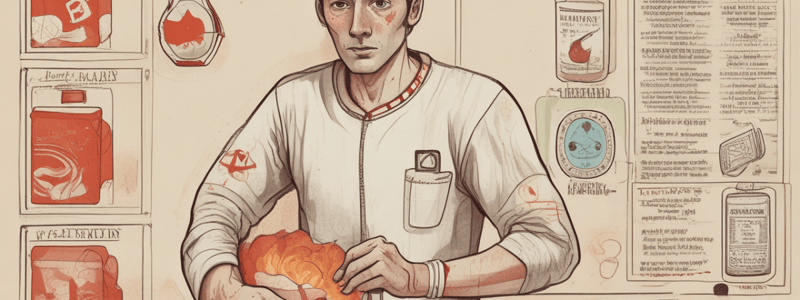Podcast
Questions and Answers
What layer of the skin is affected in a deep partial thickness burn?
What layer of the skin is affected in a deep partial thickness burn?
- Epidermis and papillary dermis
- Subcutaneous tissue and muscle
- Epidermis, papillary dermis, and reticular dermis (correct)
- Dermis and subcutaneous tissue
What is a characteristic of a third-degree burn?
What is a characteristic of a third-degree burn?
- Small blisters with no scarring
- Painful with redness and swelling
- Redness and blisters
- Leathery white appearance and insensate (correct)
How long does it take to get a full-thickness burn from scalding water at 130 F (55 C)?
How long does it take to get a full-thickness burn from scalding water at 130 F (55 C)?
- 5 seconds
- 30 seconds (correct)
- 1 minute
- 1 second
What is a characteristic of a fourth-degree burn?
What is a characteristic of a fourth-degree burn?
What is a characteristic of keloid scars?
What is a characteristic of keloid scars?
What is the first step in treating burns?
What is the first step in treating burns?
What is the goal of fluid resuscitation in burn treatment?
What is the goal of fluid resuscitation in burn treatment?
What percentage of pregnant women develop an intraoral PG in the first five months of pregnancy?
What percentage of pregnant women develop an intraoral PG in the first five months of pregnancy?
What is the most common distribution of pyogenic granuloma?
What is the most common distribution of pyogenic granuloma?
What is another name for pyogenic granuloma?
What is another name for pyogenic granuloma?
What percentage of pyogenic granuloma cases are related to systemic medications?
What percentage of pyogenic granuloma cases are related to systemic medications?
What is the treatment option for pyogenic granuloma?
What is the treatment option for pyogenic granuloma?
At what age do pyogenic granuloma peak in incidence?
At what age do pyogenic granuloma peak in incidence?
What is the characteristic of pyogenic granuloma during its growth?
What is the characteristic of pyogenic granuloma during its growth?
What is the usual appearance of pyogenic granuloma?
What is the usual appearance of pyogenic granuloma?
What is the temperature at which burns can occur in 6 hours?
What is the temperature at which burns can occur in 6 hours?
What is the primary factor in determining the severity of a burn?
What is the primary factor in determining the severity of a burn?
What is the percentage of body surface area involved in the entire head and neck of an adult?
What is the percentage of body surface area involved in the entire head and neck of an adult?
What type of burn only affects the epidermis?
What type of burn only affects the epidermis?
What is the characteristic of a second degree burn?
What is the characteristic of a second degree burn?
What is the characteristic of a superficial partial thickness burn?
What is the characteristic of a superficial partial thickness burn?
What is the percentage of body surface area involved in the perineum of an adult?
What is the percentage of body surface area involved in the perineum of an adult?
What is the temperature at which burns can occur in 1 second?
What is the temperature at which burns can occur in 1 second?
What is the possible underlying disease that can cause clubbing?
What is the possible underlying disease that can cause clubbing?
What is the characteristic of Koilonychia?
What is the characteristic of Koilonychia?
What is the possible cause of Beau Lines?
What is the possible cause of Beau Lines?
What is the characteristic of Muehrcke lines?
What is the characteristic of Muehrcke lines?
What is the treatment for Muehrcke lines?
What is the treatment for Muehrcke lines?
What is the characteristic of Terry Nails?
What is the characteristic of Terry Nails?
What is the possible underlying disease that can cause Koilonychia?
What is the possible underlying disease that can cause Koilonychia?
What is the possible underlying disease that can cause Beau Lines?
What is the possible underlying disease that can cause Beau Lines?
What is the predominant treatment for angiosarcomas of the scalp and neck?
What is the predominant treatment for angiosarcomas of the scalp and neck?
What is the characteristic histopathological feature of angiosarcoma?
What is the characteristic histopathological feature of angiosarcoma?
What is the most common cause of onychomycosis?
What is the most common cause of onychomycosis?
What is the primary goal of treatment in acute paronychia?
What is the primary goal of treatment in acute paronychia?
What is the term for the separation of the nail from the nailbed?
What is the term for the separation of the nail from the nailbed?
What is the treatment of choice for dermatophyte onychomycosis?
What is the treatment of choice for dermatophyte onychomycosis?
What is the characteristic feature of clubbing?
What is the characteristic feature of clubbing?
What is the typical cause of subungual hematoma?
What is the typical cause of subungual hematoma?
Flashcards are hidden until you start studying
Study Notes
Thermal Burns
- Burns can occur at 111°F (44°C) within 6 hours, and at 140°F (60°C) within 1 second
- The severity of a burn is judged by the depth of the burn and the percentage of body surface area (BSA) involved
- Body surface area (rule of 9's) is calculated as follows:
- Head and neck: 9%
- Right arm: 9%
- Left arm: 9%
- Right leg: 18%
- Left leg: 18%
- Anterior torso: 18%
- Posterior torso: 18%
- Perineum: 1%
- For infants up to 1 year old, the skin is still able to retain fluids, so only burns of second degree or worse are used to calculate BSA
Degrees of Burns
- First degree burn (superficial burn)
- Affects only the epidermis
- Painful, skin appears red or pink
- Heals without sequelae as epidermis is regenerated
- Second degree burn (partial thickness burn)
- Affects epidermis and part of the dermis
- May be subdivided into:
- Superficial partial thickness burn: involves epidermis and superficial dermis
- Deep partial thickness burn: involves epidermis, papillary dermis, and reticular dermis
- Often see redness and blisters, painful, but may be less painful than expected due to nerve destruction
- Heals with scarring, often treated with skin grafting to improve outcome
- Third degree burn (full thickness burn)
- Affects entire thickness of skin, including epidermis, dermis, and variable amount of subcutaneous tissue
- Leathery white appearance, often insensate (not painful)
- Generally requires skin grafting
- Fourth degree burn
- Affects entire thickness of skin, plus underlying muscle or bone
- Black charred skin
Treatment of Burns
- Maintain adequate oxygenation
- Evaluate airway for evidence of inhalation injury
- Evaluate for carbon monoxide poisoning
- Pain control
- Wound care
- Fluid resuscitation using the Parkland formula
- Goal urine output: 1 ml/kg/hr
Keloid Scars
- Have raised areas and extend beyond the original area of an injury
- May occur after severe burns or ear piercing
Vascular Tumors
- Pyogenic granuloma
- AKA lobular capillary hemangioma
- Benign vascular tumor
- Peak incidence in second and third decades of life
- Often develops at site of previous injury
- Display rapid growth
- Associated with trauma, systemic medications, and pregnancy
- Angiosarcoma
- Poorly formed vascular spaces lined by endothelial cells with cytologic atypia of nuclei
- Reddish-brown maculopapular lesion
- Plaque with crusting on forehead and anterior scalp
- Poor prognosis: 5 and 10-year survival rates are 34% and 14%, respectively
Nail Changes/Disorders
- Acute paronychia
- Superficial infection of the proximal and lateral nail folds adjacent to the nail plate
- Most commonly caused by Staphylococcus aureus or Streptococcus pyogenes
- Presents with red, swollen, and tender nail folds
- May develop associated abscess
- Treatment: topical antibiotics, warm soaks, oral antibiotics, and I&D for abscess
- Onychomycosis
- Fungal infection of nail due to dermatophyte, yeast, or nondermatophyte mold
- Most common cause is Trichophyton rubrum
- Presents with nail discoloration, subungual hyperkeratosis, splitting of nail, onycholysis, and/or nail plate destruction
- Treatment: oral antifungal therapy, particularly terbinafine
- Subungual hematoma
- Blood under the nail, usually due to trauma
- May cause throbbing pain
- Treatment: drainage/trephination of fresh hematomas, or removal of nail if symptomatic
- Clubbing
- Thickening of the nail bed's soft tissue, particularly in the proximal end
- Clinically diagnosed with an exam showing Schamroth sign
- Associated with altered vasculature, and can be a sign of numerous underlying diseases
- Koilonychia
- Upward curving of the distal nail plate, resulting in a spoon-shaped nail
- Associated with iron deficiency anemia, hemochromatosis, trauma, Raynaud disease, and other conditions
- Beau lines
- Horizontal grooves on the nail plate caused by an interruption of nail bed mitosis
- Etiologies include severe illness, Reynaud disease, pemphigus, chemotherapy, and others
- Treatment: no specific treatment other than treating any underlying condition
- Muehrcke lines
- Transverse, white bands that run parallel to the lunula across the entire width of the nail
- Etiologies include hypoalbuminemia, nephrotic syndrome, liver disease, and malnutrition
- Treatment: no specific treatment other than treating any underlying condition
- Terry nails
- Apparent leukonychia (white discoloration) of all but the most distal 2 mm of the nail bed
- Etiologies include liver disease, malnutrition, and others
Studying That Suits You
Use AI to generate personalized quizzes and flashcards to suit your learning preferences.




